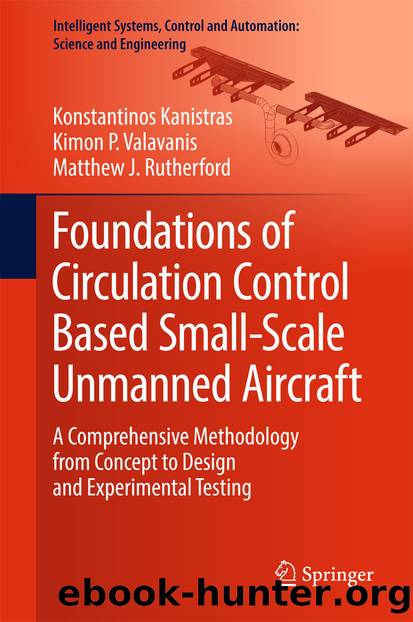Foundations of Circulation Control Based Small-Scale Unmanned Aircraft by Konstantinos Kanistras Kimon P. Valavanis & Matthew J. Rutherford

Author:Konstantinos Kanistras, Kimon P. Valavanis & Matthew J. Rutherford
Language: eng
Format: epub
Publisher: Springer International Publishing, Cham
Konstantinos Kanistras (Corresponding author)
Email: [email protected]
Kimon P. Valavanis
Email: [email protected]
Matthew J. Rutherford
Email: [email protected]
Observation is a passive science, experimentation an active science
—Claud Bernard
Low Reynolds numbers (Re2.2 10) wind tunnel tests are conducted and the results are presented here. Based on the wind tunnel specifications and the focus on small-scale platforms, 2-D and 3-D wind tunnel tests are conducted based on the assumption that most of the platforms at that scale operate at the same Reynolds numbers. The platform, which is described in Sect. 9.1, is chosen because of the fact that the average speed that operates is the speed that the wind tunnel wing models are tested.
The experimental results of all CCWs are presented, compared, and discussed. The effect of blowing on lift and drag coefficients is presented along with the improved lift-to-drag ratios. Lift augmentation ratio results are shown and a comparison between all surfaces tested show that CC works at all configurations and with upper slot blowing, lift enhancement is achieved. The qualified wing configuration (NACA 0015 CCW) is tested (2-D wind tunnel test) with two dual radius flap configurations and the results are presented next.
Before moving on to the analysis of the results, it is important to understand the level of uncertainty of the measurements and the parameters that may not be controllable during a wind tunnel test. A block diagram representation of a wind tunnel experiment is shown in Fig. 8.1. The inputs can be parameters that define the experiment as: angle of attack of the wing, roll, pitch, yaw, etc. and in general the initial conditions that are set. Elements that are controlled and defined by the researcher are the: model size, tunnel size, model material, and time of the experiment. The elements of the output vector are the parameters that need to be investigated and are defined by the experiment and are known a-priori. Those elements can be forces, moments components as indicated by the balance, pressure readings, video image, or smoke visualization methods, etc. At last, uncontrollable factors include variables as turbulence level of incoming stream, temperature, relative humidity, model deformation, etc. Even though in principle a parameter should be controllable, it may be uncontrollable. Barlow et al. [63] state that the scope of the parameters that are controllable depends on the resources available to the experiment planner.
Fig. 8.1Conceptual model of an experimental setup, schematic inspired by [63]
Download
This site does not store any files on its server. We only index and link to content provided by other sites. Please contact the content providers to delete copyright contents if any and email us, we'll remove relevant links or contents immediately.
| Automotive | Engineering |
| Transportation |
Whiskies Galore by Ian Buxton(41533)
Introduction to Aircraft Design (Cambridge Aerospace Series) by John P. Fielding(32890)
Small Unmanned Fixed-wing Aircraft Design by Andrew J. Keane Andras Sobester James P. Scanlan & András Sóbester & James P. Scanlan(32574)
Craft Beer for the Homebrewer by Michael Agnew(17935)
Turbulence by E. J. Noyes(7702)
The Complete Stick Figure Physics Tutorials by Allen Sarah(7143)
Kaplan MCAT General Chemistry Review by Kaplan(6597)
The Thirst by Nesbo Jo(6439)
Bad Blood by John Carreyrou(6278)
Modelling of Convective Heat and Mass Transfer in Rotating Flows by Igor V. Shevchuk(6225)
Learning SQL by Alan Beaulieu(6037)
Weapons of Math Destruction by Cathy O'Neil(5832)
Man-made Catastrophes and Risk Information Concealment by Dmitry Chernov & Didier Sornette(5650)
Digital Minimalism by Cal Newport;(5392)
Life 3.0: Being Human in the Age of Artificial Intelligence by Tegmark Max(5189)
iGen by Jean M. Twenge(5163)
Secrets of Antigravity Propulsion: Tesla, UFOs, and Classified Aerospace Technology by Ph.D. Paul A. Laviolette(4994)
Design of Trajectory Optimization Approach for Space Maneuver Vehicle Skip Entry Problems by Runqi Chai & Al Savvaris & Antonios Tsourdos & Senchun Chai(4843)
Electronic Devices & Circuits by Jacob Millman & Christos C. Halkias(4749)
